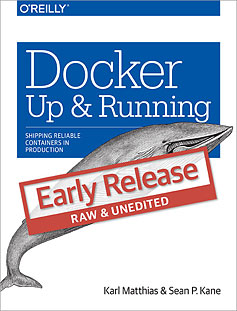"operations" entries

Signals from the 2015 O’Reilly Velocity Conference in Amsterdam
Key insights from DevOps, Web operations, and performance.
People from across the Web operations and performance worlds came together for the 2015 O’Reilly Velocity Conference in Amsterdam. Below, we’ve assembled notable material from the event.
The Physical Web: A bridge between the Web and physical devices
The app-for-everything approach doesn’t scale, but the Web does. Scott Jenson, project lead for Physical Web at Google, outlines a vision for the Physical Web — an open approach to design and implementation that brings Web interaction to the physical world. “Let’s take the URL bar and bring it in the future,” Jenson says.

DevOps for Finance
How DevOps will help you surpass the common challenges of financial services software development.

Download DevOps for Finance.
Download a free copy of DevOps for Finance, an O’Reilly report by Jim Bird for the financial services software insider who’s heard about DevOps, but is unsure whether it represents solution or suicide.
DevOps, until recently, has been a story about unicorns. Innovative, engineering-driven online tech companies like Flickr, Etsy, Twitter, Facebook, and Google. Netflix and its Chaos Monkey. Amazon deploying thousands of changes per day.
DevOps was originally about WebOps at Internet companies working in the Cloud, and a handful of Lean Startups in Silicon Valley. It started at these companies because they had to move quickly, so they found new, simple, and collaborative ways of working that allowed them to innovate much faster and to scale much more effectively than organizations had done before.
But as the velocity of change in business continues to increase, enterprises — sometimes referred to as “horses,” in contrast to the unicorns referenced above — must also move to deliver content and features to customers just as quickly. These large organizations have started to adopt (and, along the way, adapt) DevOps ideas, practices, and tools.
This short book assumes that you have heard about DevOps and want to understand how DevOps practices like Continuous Delivery and Infrastructure as Code can be used to solve problems in financial systems at a trading firm, or a big bank or stock exchange. We’ll look at the following key ideas in DevOps, and how they fit into the world of financial systems:
- Breaking down the “wall of confusion” between development and operations, and extending Agile practices and values from development to operations
- Using automated configuration management tools like Chef, Puppet, CFEngine, or Ansible to programmatically provision and configure systems (Infrastructure as Code)
- Building Continuous Integration and Continuous Delivery (CI/CD) pipelines to automatically test and push out changes, and wiring security and compliance into these pipelines
- Using containerization and virtualization technologies like Docker and Vagrant, together with Infrastructure as Code, to create IaaS, PaaS, and SaaS clouds
- Running experiments, creating fast feedback loops, and learning from failure
To follow this book you need to understand a little about these ideas and practices. There is a lot of good stuff about DevOps out there, amid the hype. Read more…

It’s usability all the way down
Designing, building, and operating services from the perspective of customer goals helps improve quality.

We often tend to think about “usability” as applying to a separate layer of digital service from functionality or operability. We treat it as a characteristic of an interface which intermediates between the user and an application’s utility. Operational concerns such as performance, resilience, or security are even further removed. This approach gets reflected in siloed design-development-operations practices. From the perspective of service quality, though, I think it may be more constructive to view usability as a characteristic of service as a whole.
What is service, anyway? In the language of service-dominant logic, it’s something that helps a customer accomplish a job-to-be-done. From that perspective, usability refers to the customer’s ability to ‘use’ the service to accomplish their goals. Everything that contributes to, or compromises, that ability, impacts usability.

Set up Kubernetes with a Docker compose one-liner
Start exploring Kubernetes with minimal effort.

I had not looked at Kubernetes in over a month. It is a fast paced project so it is hard to keep up. If you have not looked at Kubernetes, it is roughly a cluster manager for containers. It takes a set of Docker hosts under management and schedules groups of containers in them. Kubernetes was open sourced by Google around June last year to bring all the Google knowledge of working with containers to us, a.k.a The people :) There are a lot of container schedulers or orchestrators if you wish out there, Citadel, Docker Swarm, Mesos with the Marathon framework, Cloud Foundry lattice etc. The Docker ecosystem is booming and our heads are spinning.
What I find very interesting with Kubernetes is the concept of replication controllers. Not only can you schedule groups of colocated containers together in a cluster, but you can also define replica sets. Say you have a container you want to scale up or down, you can define a replica controller and use it to resize the number of containers running. It is great for scaling when the load dictates it, but it is also great when you want to replace a container with a new image. Kubernetes also exposes a concept of services basically a way to expose a container application to all the hosts in your cluster as if it were running locally. Think the ambassador pattern of the early Docker days but on steroids.

Applied DevOps and the potential of Docker
The cultural impact within a software engineering organization can be dramatic.
Editor’s note: this post is from Karl Matthias and Sean P. Kane, authors of “Docker Up & Running,” a guide to quickly learn how to use Docker to create packaged images for easy management, testing, and deployment of software.
At the Python Developers Conference in Santa Clara, California, on March 15th, 2013, with no pre-announcement and little fanfare, Solomon Hykes, the founder and CEO of dotCloud, gave a 5-minute lightning talk where he first introduced the world to a brand new tool for Linux called Docker. It was a response to the hardships of shipping software at scale in a fast-paced world, and takes an approach that makes it easy to map organizational processes to the principles of DevOps.
The capabilities of the typical software engineering company have often not kept pace with the quickly evolving expectations of the average technology user. Users today expect fast, reliable systems with continuous improvements, ease of use, and broad integrations. Many in the industry see the principles of DevOps as a giant leap toward building organizations that meet the challenges of delivering high quality software in today’s market. Docker is aimed at these challenges.

How we got to the HTTP/2 and HPACK RFCs
A brief history of SPDY and HTTP/2.

Download HTTP/2.
SPDY was an experimental protocol, developed at Google and announced in mid-2009, whose primary goal was to try to reduce the load latency of web pages by addressing some of the well-known performance limitations of HTTP/1.1. Specifically, the outlined project goals were set as follows:
- Target a 50% reduction in page load time (PLT).
- Avoid the need for any changes to content by website authors.
- Minimize deployment complexity, avoid changes in network infrastructure.
- Develop this new protocol in partnership with the open-source community.
- Gather real performance data to (in)validate the experimental protocol.
To achieve the 50% PLT improvement, SPDY aimed to make more efficient use of the underlying TCP connection by introducing a new binary framing layer to enable request and response multiplexing, prioritization, and header compression.
Not long after the initial announcement, Mike Belshe and Roberto Peon, both software engineers at Google, shared their first results, documentation, and source code for the experimental implementation of the new SPDY protocol:
So far we have only tested SPDY in lab conditions. The initial results are very encouraging: when we download the top 25 websites over simulated home network connections, we see a significant improvement in performance—pages loaded up to 55% faster.
— A 2x Faster Web Chromium Blog
Fast-forward to 2012 and the new experimental protocol was supported in Chrome, Firefox, and Opera, and a rapidly growing number of sites, both large (e.g. Google, Twitter, Facebook) and small, were deploying SPDY within their infrastructure. In effect, SPDY was on track to become a de facto standard through growing industry adoption.

Deploy Continuous Improvement
Balancing the work it takes to improve capability against delivery work that provides value to customers.

Download
Building an Optimized Business
Download a free copy of Building an Optimized Business, a curated collection of chapters from the O’Reilly Web Operations and Performance library. This post is an excerpt by Jez Humble, Joanne Molesky, and Barry O’Reilly from Lean Enterprise, one of the selections included in the curated collection.
In most enterprises, there is a distinction between the people who build and run software systems (often referred to as “IT”) and those who decide what the software should do and make the investment decisions (often called “the business”). These names are relics of a bygone age in which IT was considered a cost necessary to improve efficiencies of the business, not a creator of value for external customers by building products and services. These names and the functional separation have stuck in many organizations (as has the relationship between them, and the mindset that often goes with the relationship). Ultimately, we aim to remove this distinction. In high-performance organizations today, people who design, build, and run software-based products are an integral part of business; they are given — and accept — responsibility for customer outcomes. But getting to this state is hard, and it’s all too easy to slip back into the old ways of doing things.

How to leverage the browser cache with a CDN
An introduction to multi-level caching.

Since a content delivery network (CDN) is essentially a cache, you might be tempted not to make use of the cache in the browser, to avoid complexity. However, each cache has its own advantages that the other does not provide. In this post I will explain what the advantages of each are, and how to combine the two for the most optimal performance of your website.
Why use both?
While CDNs do a good job of delivering assets very quickly, they can’t do much about users who are out in the boonies and barely have a single bar of reception on their phone. As a matter of fact, in the US, the 95th percentile for the round trip time (RTT) to all CDNs is well in excess of 200 milliseconds, according to Cedexis reports. That means at least 5% of your users, if not more, are likely to have a slow experience with your website or application. For reference, the 50th percentile, or median, RTT is around 45 milliseconds.
So why bother using a CDN at all? Why not just rely on the browser cache?

What is DevOps (yet again)?
Empathy, communication, and collaboration across organizational boundaries.

I might try to define DevOps as the movement that doesn’t want to be defined. Or as the movement that wants to evade the inevitable cargo-culting that goes with most technical movements. Or the non-movement that’s resisting becoming a movement. I’ve written enough about “what is DevOps” that I should probably be given an honorary doctorate in DevOps Studies.
Baron Schwartz (among others) thinks it’s high time to have a definition, and that only a definition will save DevOps from an identity crisis. Without a definition, it’s subject to the whims of individual interest groups, and ultimately might become a movement that’s defined by nothing more than the desire to “not be like them.” Dave Zwieback (among others) says that the lack of a definition is more of a blessing than a curse, because it “continues to be an open conversation about making our organizations better.” Both have good points. Is it possible to frame DevOps in a way that preserves the openness of the conversation, while giving it some definition? I think so.
DevOps started as an attempt to think long and hard about the realities of running a modern web site, a problem that has only gotten more difficult over the years. How do we build and maintain critical sites that are increasingly complex, have stringent requirements for performance and uptime, and support thousands or millions of users? How do we avoid the “throw it over the wall” mentality, in which an operations team gets the fallout of the development teams’ bugs? How do we involve developers in maintenance without compromising their ability to release new software?

If it weren’t for the people…
A humanist approach to automation.
 Editor’s note: At some point, we’ve all read the accounts in newspapers or on blogs that “human error” was responsible for a Twitter outage, or worse, a horrible accident. Automation is often hailed as the heroic answer, poised to eliminate the specter of human error. This guest post from Steven Shorrock, who will be delivering a keynote speech at Velocity in Barcelona, exposes human error as dangerous shorthand. The more nuanced way through involves systems thinking, marrying the complex fabric of humans and the machines we work with every day.
Editor’s note: At some point, we’ve all read the accounts in newspapers or on blogs that “human error” was responsible for a Twitter outage, or worse, a horrible accident. Automation is often hailed as the heroic answer, poised to eliminate the specter of human error. This guest post from Steven Shorrock, who will be delivering a keynote speech at Velocity in Barcelona, exposes human error as dangerous shorthand. The more nuanced way through involves systems thinking, marrying the complex fabric of humans and the machines we work with every day.
In Kurt Vonnegut’s dystopian novel ‘Player Piano’, automation has replaced most human labour. Anything that can be automated, is automated. Ordinary people have been robbed of their work, and with it purpose, meaning and satisfaction, leaving the managers, scientists and engineers to run the show. Dr Paul Proteus is a top manager-engineer at the head of the Ilium Works. But Proteus, aware of the unfairness of the situation for the people on the other side of the river, becomes disillusioned with society and has a moral awakening. In the penultimate chapter, Paul and his best friend Finnerty, a brilliant young engineer turned rogue-rebel, reminisce sardonically: “If only it weren’t for the people, the goddamned people,” said Finnerty, “always getting tangled up in the machinery. If it weren’t for them, earth would be an engineer’s paradise.”
